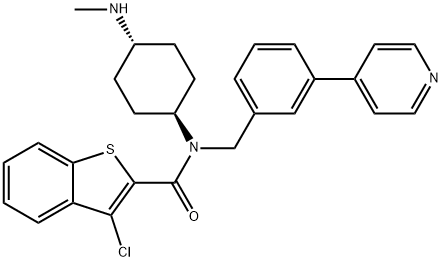SAFETY INFORMATION
| Signal word | Danger |
|---|---|
| Pictogram(s) |
 Skull and Crossbones Acute Toxicity GHS06 |
| GHS Hazard Statements |
H301:Acute toxicity,oral H413:Hazardous to the aquatic environment, long-term hazard |
| Precautionary Statement Codes |
P273:Avoid release to the environment. |
COMPUTED DESCRIPTORS
| Molecular Weight | 490.1 g/mol |
|---|---|
| XLogP3 | 6.3 |
| Hydrogen Bond Donor Count | 1 |
| Hydrogen Bond Acceptor Count | 4 |
| Rotatable Bond Count | 6 |
| Exact Mass | 489.1641614 g/mol |
| Monoisotopic Mass | 489.1641614 g/mol |
| Topological Polar Surface Area | 73.5 Ų |
| Heavy Atom Count | 34 |
| Formal Charge | 0 |
| Complexity | 666 |
| Isotope Atom Count | 0 |
| Defined Atom Stereocenter Count | 0 |
| Undefined Atom Stereocenter Count | 0 |
| Defined Bond Stereocenter Count | 0 |
| Undefined Bond Stereocenter Count | 0 |
| Covalently-Bonded Unit Count | 1 |
| Compound Is Canonicalized | Yes |
PRODUCT INTRODUCTION
description
3-chloro-N-[trans-4-(methylamino)cyclohexyl]-N-[3-(pyridin-4-yl)benzyl]-1-benzothiophene-2-carboxamide is a member of the class of 1-benzothiophenes that is 3-chloro-1-benzothiophene-2-carboxamide in which the amide nitrogen is substituted by trans-4-(methylamino)cyclohexyl and 3-(pyridin-4-yl)benzyl groups. A smoothened (Smo) receptor agonist that antagonizes cyclopamine action at the Smo receptor. Activates the Hedgehog signaling pathway in a Patched independent manner. It has a role as a SMO receptor agonist. It is a member of 1-benzothiophenes, an organochlorine compound, a biaryl, a phenylpyridine, a tertiary carboxamide and a secondary amino compound.
